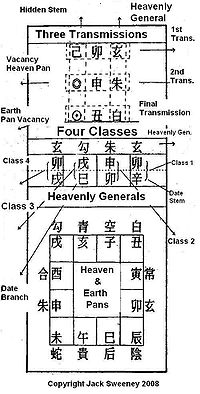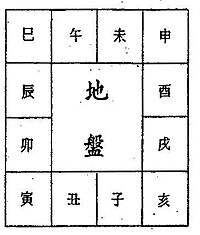- Da Liu Ren
-
Da Liu Ren (Chinese: 大六壬 pinyin: dàliùrén) is a form of Chinese calendrical astrology dating from (at least) the later Warring States period.[1]
Along with the divination methods Qi Men Dun Jia 奇门遁甲 and Taiyi 太乙—collectively known as the "Three Styles" (San shi 三式)—Da Liu Ren is considered in China to be one of the highest forms of Chinese metaphysics.
It is called Da Liu Ren because in the Sexegenary cycle there are Six Rens each with a different branch:
壬申 壬午 壬辰 壬寅 壬子 壬戌
Ren Shen, Ren Wu, Ren Chen, Ren Yin, Ren Zi and Ren Xu
In the words of a contemporary Chinese master of Da Liu Ren, the six Ren indicate an entire movement of the sexegenary cycle, during which an event – object may appear, rise to maturity and then decline and disappear. Thus the six Ren indicate the life cycle of phenomena. There is a homonym in the Chinese language which carries the meaning of pregnancy, and so the six Ren also carry this meaning, that of the term of the birth of a phenomenon, its maturity and its passing, all within the period of a sexegenary cycle.[2]
Contents
Instrument
The diviner's board (shi) used for the Three Styles differ markedly. The Qi Men Dun Jia divinor's board consists of a 3 × 3 magic square, while the Tai Yi board is somewhat larger, and may be drawn as either a square or circle. The Da Liu Ren cosmic board contains positions for the Earth pan and Heaven pan, which hold the twelve Earth Branches and the twelve spirits. In addition, the Da Liu Ren cosmic board indicates the Three Transmissions (san chuan 三传) and Four Classes (四课).
A shi (also known as a liuren astrolabe) from the Six Dynasties period (222–589 CE) consists of a Heaven Plate 天盘 placed over an Earth Plate 地盘. On the Earth Plate are three groups of inscriptions:[1]
- Outer band: 36 animals (12 associated with the Branches plus the 28 animals associated with the xiu or lunar mansions)
- Middle band: 28 xiu
- Inner ring: Stems and Branches (ganzhi).
The square plate is divided diagonally into four sections that allocate 9 animals, 7 xiu, and 5 ganzhi to a section.
A diviner examined current sky phenomena to set the board and adjust their position in relation to the board.[3]
A modern version of the Da Liu Ren cosmic board places the Three Transmissions at the top of the board, along with the corresponding Earth Branch and any pertinent vacancies.
The Four Classes are placed below the Three Transmissions, with the Heaven Pan and Earth Pan positions clearly indicated below the corresponding spirit position.
A diagram of the Heaven Pan positions of the twelve generals and their corresponding Earth Branch positions in the Heaven Pan completes the illustration. The Earth pan is not depicted.
The sexegenary cycle date is given in the upper right – hand margin, with the corresponding situation (Ju) number, the location of pertinent vacancies, and an indication of whether the array belongs to daytime or evening divination.
The structured situation types for each array are provided in the left-hand margin. In some versions, an annotated description of the major aspects of each situation is provided. The description is often taken from the body of classical literature about Da Liu Ren.[4]
Technique
Divination in Da Liu Ren is determined by relationships of five elements (wu xing 五行) and yin and yang (阴阳) between and among the Three Transmissions (San chuan 三传), Four Classes (Si ke 四课), Twelve Generals, and the Heaven and Earth Plates.
Each double-hour of the day contains a cosmic board for daytime and evening divination. The Three Transmissions are derived from configurations of the Heavenly Stem of the date, and the Earthly Branch of the date. The Four Classes are determined in a similar manner.
See also
- Qi Men Dun Jia
- Tai Yi Shen Shu
- Feng Shui
- I Ching
- Yijing
- Chinese Astrology
- Chinese Astronomy
- Chinese Classical Texts
- Siku Quanshu
- Monadology – the metaphysical basis for synchronicity provided in 1714 by Gottfried Leibnitz, another student of the I Ching.
- Flying Star Feng Shui
References
- "Da Liu Ren Divination" by Jack Sweeney
- "Book of Changes And Traditional Chinese Medicine, Yang Li (Language: English)
Published by Beijing Science and Technology Press, 1998 Paperback, 7.9 × 5.5 inches, 575 pages ISBN 7-5304-2025-9, 978-7-5304-2025-6
Further reading
- Yijing
- "Chinese Mathematical Astrology" by Ho Peng Yoke
- "Da Liu Ren Bi Jing" (大六壬必镜)
- "Da Liu Ren Divination" by Jack Sweeney (2008)
- "The Philosophy of Da Liu Ren" by Jack Sweeney (2009)
- "Da Liu Ren Feng Shui" by Jack Sweeney (2008)
- "Da Liu Ren Dream Analysis" by Jack Sweeney (2009)
- "Da Liu Ren 1,440 Arrays" by Jack Sweeney (2008)
- "Liu Ren Da Quan"(六壬大全 Encyclopedia of Liu Ren), published in the Qing Dynasty Imperial Archive, known as the Four Treasures (四库)
- "Liu Ren Guan Ge Shen Shu" (六壬管辂神书)
- "Personal Fortunes in Da Liu Ren" by Jack Sweeney (2009)
- "Lingtai jing," an astrological treatise preserved in the Daoist canon (Daozang)
- Marc Kalinowski, “La littérature divinatoire dans le Daozang,” Cahiers d’Extrême-Asie no. 5 (1989–1990), p. 91; and Kalinowski, “Les manuscrits astro-calendériques des Han,” pp. 396–401
External links
- [www.phoenixanddragonfengshui.com/index.asp] Da Liu Ren website of Jack Sweeney.
Categories:- Chinese books of divination
- Chinese astrology
- Astrological texts
- Divination
- Taoism
- History of astrology
Wikimedia Foundation. 2010.


